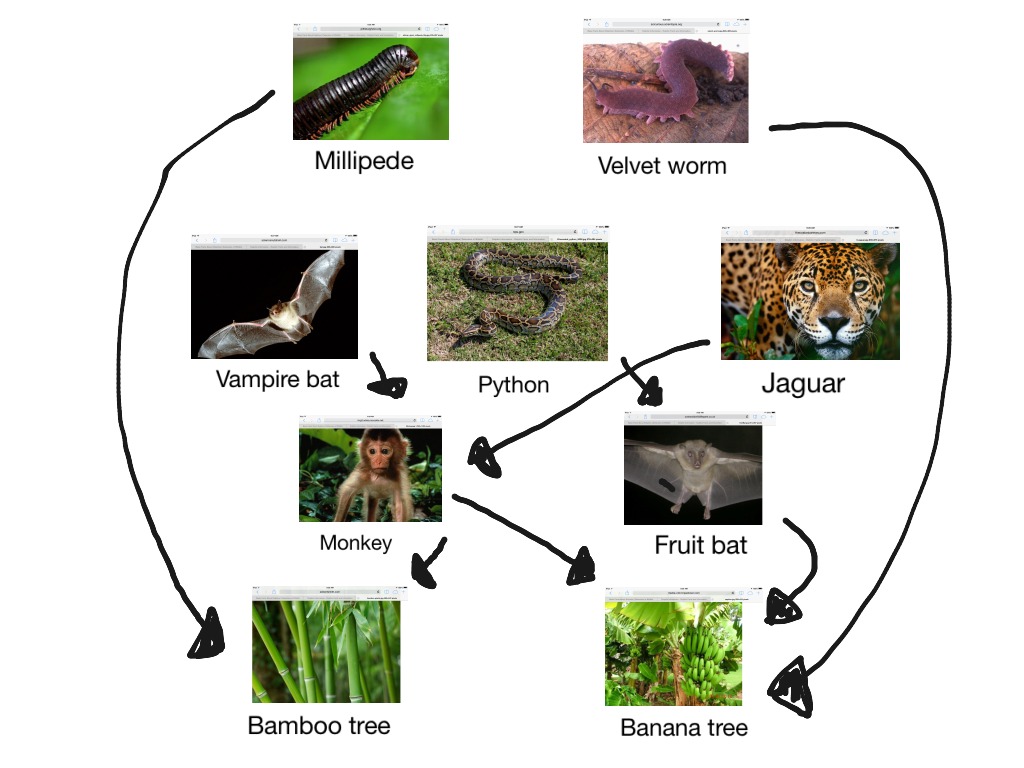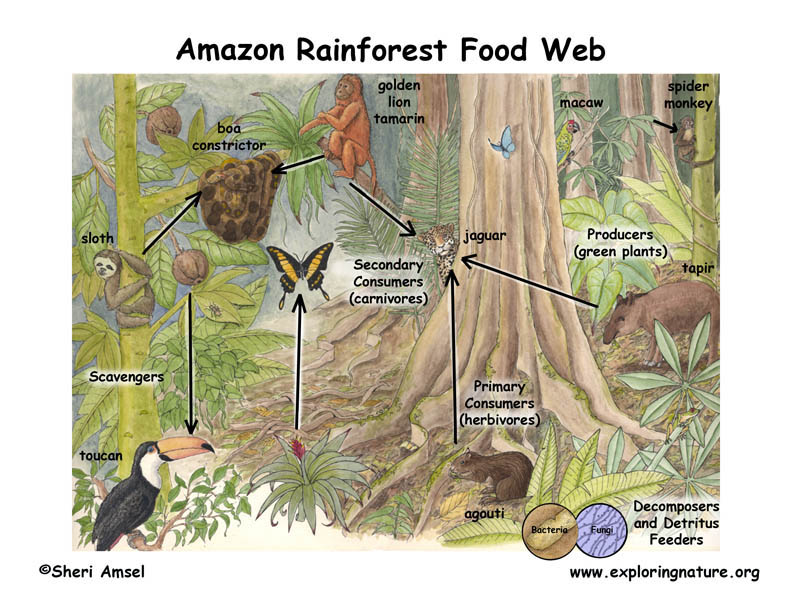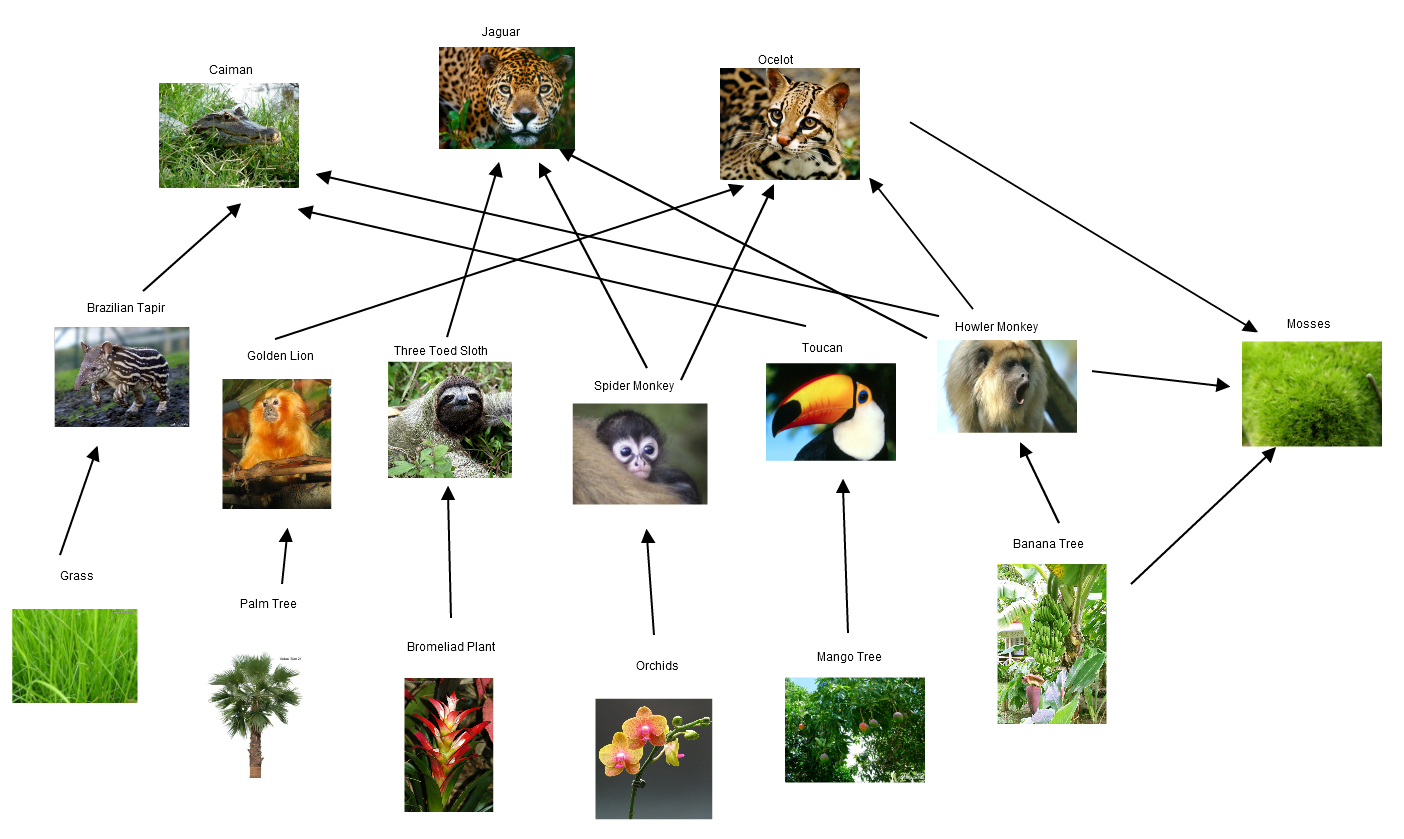Meals net of rainforest – Meals Internet of the Rainforest: Dive into the fascinating tapestry of life inside the lush rainforests, the place intricate connections and dependencies form the very essence of survival. From the tiniest decomposers to the majestic apex predators, every organism performs an important function in sustaining the fragile steadiness of this vibrant ecosystem.
On this exploration, we’ll unravel the complexities of the rainforest meals net, analyzing the interconnectedness of trophic ranges and the variations that permit organisms to thrive on this verdant realm.
Major Producers: Meals Internet Of Rainforest

Major producers kind the muse of the rainforest meals net, changing daylight into vitality by means of photosynthesis. This course of helps your entire ecosystem by offering the first supply of vitamins and vitality for all different organisms.
The primary major producers in a rainforest are crops, algae, and sure micro organism. Crops are essentially the most plentiful and numerous major producers, with timber, shrubs, and vines dominating the cover and understory. Algae are present in each aquatic and terrestrial environments, whereas micro organism play an important function in nutrient biking and decomposition.
Variations of Major Producers
Rainforest major producers have advanced particular variations to thrive within the distinctive circumstances of the rainforest, together with:
- Broad leaves:Giant, broad leaves maximize daylight absorption for photosynthesis.
- Waxy cuticles:Waxy coatings on leaves cut back water loss by means of transpiration.
- Buttress roots:Broad, spreading roots present stability in shallow, nutrient-poor soil.
li> Epiphytes:Crops that develop on different crops, using daylight and moisture with out competing for soil vitamins.
Major Shoppers
Major customers, often known as herbivores, kind the muse of the rainforest meals net by consuming major producers, similar to crops and algae.
The range of major customers in a rainforest is astounding, starting from tiny bugs to giant mammals. Every species has advanced distinctive feeding methods and ecological niches to use completely different plant assets.
Feeding Methods and Ecological Niches
Major customers make use of a variety of feeding methods to entry plant materials. Some, like leaf-cutter ants, focus on chopping and transporting leaves again to their colonies, the place they domesticate fungus gardens as their major meals supply.
Others, similar to howler monkeys, are arboreal herbivores that feed on leaves, fruits, and flowers excessive within the cover. Their giant measurement and prehensile tails permit them to navigate the advanced rainforest construction and entry meals sources inaccessible to smaller animals.
Significance of Herbivory
Herbivory performs an important function in sustaining the steadiness and variety of rainforest ecosystems. By consuming crops, major customers regulate plant populations, stopping anybody species from dominating and inhibiting the expansion of others.
Herbivory additionally shapes plant communities by selectively grazing on sure species, influencing plant succession and making a mosaic of habitats that assist a variety of species.
Secondary Shoppers
Secondary customers in a rainforest meals net occupy an important place, bridging the hole between major customers and prime predators. They play a major function in sustaining the fragile steadiness of the ecosystem.
Secondary customers may be broadly labeled into two teams: predators and scavengers. Predators actively hunt and kill their prey, whereas scavengers feed on the stays of animals which have died from different causes.
Predators
- Predators embrace a various array of animals, similar to carnivorous mammals (e.g., jaguars, ocelots), reptiles (e.g., snakes, crocodiles), and birds (e.g., hawks, eagles).
- Predators play a important function in regulating populations of major customers, stopping their numbers from spiraling uncontrolled.
- They possess variations that improve their looking talents, similar to sharp claws, highly effective jaws, and eager senses.
Scavengers, Meals net of rainforest
- Scavengers embrace animals like vultures, hyenas, and sure bugs.
- They feed on carcasses and decaying matter, serving to to scrub up the ecosystem and forestall the unfold of illness.
- Scavengers have tailored to their scavenging life-style, possessing eager senses of scent and sharp beaks or tooth for tearing by means of flesh.
Tertiary Shoppers

Tertiary customers occupy the best trophic stage in a rainforest meals net, also known as apex predators. These formidable hunters are on the pinnacle of the ecosystem’s meals chain, preying upon secondary customers and sometimes major customers.
The presence of apex predators is essential for sustaining a balanced rainforest ecosystem. They exert top-down management over decrease trophic ranges, stopping overpopulation of prey species. This, in flip, permits for the preservation of plant variety and the general stability of the rainforest habitat.
Threats Confronted by Tertiary Shoppers
- Habitat loss:Deforestation and fragmentation of rainforests cut back the obtainable habitat for tertiary customers, making it troublesome for them to search out meals and shelter.
- Searching:Tertiary customers are sometimes focused by people for sport looking or for his or her fur, pores and skin, or different physique elements.
- Air pollution:Contaminants from industrial actions and agricultural runoff can accumulate within the meals chain, poisoning tertiary customers.
- Local weather change:Rising temperatures and altered precipitation patterns can have an effect on the provision of prey species, making it difficult for tertiary customers to outlive.
Decomposers

Decomposers play an important function within the rainforest ecosystem, breaking down useless natural matter and returning vitamins to the soil. These organisms embrace micro organism, fungi, and invertebrates, similar to termites and earthworms.
Decomposers provoke the method of nutrient biking, changing natural matter into inorganic kinds that may be utilized by crops. This course of ensures the continual availability of important vitamins for plant development and ecosystem productiveness.
Variations of Decomposers
Decomposers have advanced particular variations to effectively break down natural matter. These variations embrace:
- Enzyme manufacturing:Decomposers produce enzymes that break down advanced natural compounds into less complicated molecules.
- Acid secretion:Some decomposers secrete acids to dissolve natural matter and facilitate its decomposition.
- Symbiotic relationships:Sure decomposers kind symbiotic relationships with different organisms, similar to fungi with crops (mycorrhizae), to boost nutrient acquisition and decomposition.
- Tolerance to harsh circumstances:Decomposers usually thrive in nutrient-poor and acidic environments, the place different organisms wrestle to outlive.
Meals Internet Dynamics
Rainforest meals webs are continually altering as a result of a wide range of environmental components. These components can embrace adjustments in local weather, habitat loss, and the introduction of invasive species.Local weather change can have a major influence on rainforest meals webs. For instance, adjustments in temperature and precipitation can have an effect on the distribution and abundance of crops and animals.
This will in flip have an effect on the meals sources for different animals, resulting in adjustments in your entire meals net.
Conservation Implications
Rainforest meals webs are essential for the steadiness and well being of the ecosystem. Conserving these meals webs is important to take care of biodiversity, ecosystem providers, and the general well-being of the planet.Threats to rainforest meals webs embrace deforestation, habitat loss, air pollution, local weather change, and overexploitation.
Deforestation and habitat loss fragment and destroy habitats, disrupting the move of vitality and vitamins by means of the meals net. Air pollution can accumulate in organisms, affecting their well being and reproductive success. Local weather change alters species’ distributions and interactions, resulting in disruptions within the meals net.
Overexploitation of species, similar to looking and logging, can deplete populations and disrupt the steadiness of the ecosystem.Conservation methods for safeguarding rainforest meals webs embrace:
Establishing protected areas and lowering deforestation
Establishing nationwide parks, reserves, and different protected areas helps protect rainforest habitats and cut back human impacts. Lowering deforestation by means of sustainable land administration practices and reforestation efforts can also be essential.
Controlling air pollution
Implementing rules and selling sustainable practices to scale back air pollution from industrial actions, agriculture, and transportation helps shield rainforest ecosystems and the species they assist.
Mitigating local weather change
Taking motion to scale back greenhouse fuel emissions and mitigate the results of local weather change is important to guard rainforest meals webs and the planet as a complete.
Sustainable harvesting and wildlife administration
Implementing sustainable harvesting practices and wildlife administration plans helps stop overexploitation of species and keep the steadiness of the ecosystem.
Schooling and consciousness
Elevating consciousness concerning the significance of rainforest meals webs and selling accountable conduct may help shield these ecosystems and the species they assist.
Generally Requested Questions
What’s the significance of major producers within the rainforest meals net?
Major producers, similar to crops, are the muse of the rainforest meals net, changing daylight into vitality by means of photosynthesis, which helps all different trophic ranges.
How do secondary customers contribute to the steadiness of the rainforest ecosystem?
Secondary customers, together with predators and scavengers, play an important function in regulating populations, stopping overpopulation and sustaining a wholesome steadiness amongst species.
What are the variations that allow decomposers to thrive within the rainforest surroundings?
Decomposers have advanced specialised enzymes and symbiotic relationships to interrupt down advanced natural matter effectively, contributing to nutrient biking and supporting the expansion of major producers.




